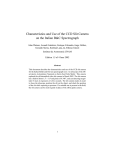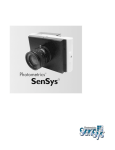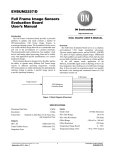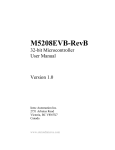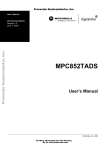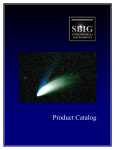Download MTD PS Specifications
Transcript
USERS MANUAL Revision 8.0 MTD/PS-0215 January 2, 2008 KODAK KAF SERIES CCD DIGITAL REFERENCE EVALUATION BOARD USERS MANUAL TABLE OF CONTENTS Introduction................................................................................................................................................................................. 5 Overview ...................................................................................................................................................................................... 5 Specifications .............................................................................................................................................................................. 6 Outputs: .......................................................................................................................................................................................6 Inputs: TTL.................................................................................................................................................................................6 Architecture Overview ................................................................................................................................................................. 7 Master Clock ...............................................................................................................................................................................7 PLD1 ............................................................................................................................................................................................7 PLD2 ............................................................................................................................................................................................7 CCD Clock Drivers.......................................................................................................................................................................7 CCD Bias Voltages.......................................................................................................................................................................8 CCD Image Sensor ......................................................................................................................................................................8 A/D Converter: Analog Devices AD9816 .....................................................................................................................................8 Emitter Follower .........................................................................................................................................................................8 AC Coupling Capacitor ................................................................................................................................................................8 Power on Clear / Reset ...............................................................................................................................................................8 JTAG Header................................................................................................................................................................................8 Unit Integration Time ..................................................................................................................................................................9 J6 Input Connector ......................................................................................................................................................................9 J4 Output Connector ...................................................................................................................................................................9 J7 Integration Sync......................................................................................................................................................................9 J1, J2 Imager Board Connectors..............................................................................................................................................10 Power Supplies..........................................................................................................................................................................10 J5 Power Connector..................................................................................................................................................................10 Board Requirements:................................................................................................................................................................ 11 Power Supply.............................................................................................................................................................................11 Inputs .........................................................................................................................................................................................11 Outputs ......................................................................................................................................................................................11 JTAG Programming...................................................................................................................................................................11 Configuration Modes................................................................................................................................................................. 12 Line/Switches Modes ................................................................................................................................................................12 Still/Free-Run Modes................................................................................................................................................................12 AD_IN/EX Modes .......................................................................................................................................................................13 EXT: ........................................................................................................................................................................................13 INT:.........................................................................................................................................................................................13 Adjustments...............................................................................................................................................................................14 CCD Modes ................................................................................................................................................................................14 Binning Modes...........................................................................................................................................................................14 Integration Modes .....................................................................................................................................................................14 Frame Grabber Diagnostic Modes ...........................................................................................................................................14 Power Supply Modes.................................................................................................................................................................15 Switching Power Supply ........................................................................................................................................................15 External Supply Operation ....................................................................................................................................................15 Functionality ..........................................................................................................................................................................15 CCD Imager Boards .................................................................................................................................................................. 16 Adjustments...............................................................................................................................................................................16 Fixed Bias Voltages: ..............................................................................................................................................................16 Variable Bias Voltages:..........................................................................................................................................................16 ©Eastman Kodak Company, 2008 www.kodak.com/go/imagers Revision 8.0 MTD/PS-0215 p2 Output Selection for Sensors with Two Outputs ......................................................................................................................17 Timing........................................................................................................................................................................................ 18 Fixed Timing: .............................................................................................................................................................................18 Variable Timing: ........................................................................................................................................................................18 Other Parameters ..................................................................................................................................................................... 18 Fixed Parameters:.....................................................................................................................................................................18 Variable Parameters: ................................................................................................................................................................18 Figures, Tables, Timing Diagrams, and Performance Data..................................................................................................... 19 System Noise Floor Vs. Operating Frequency .........................................................................................................................35 Connector Pinouts.....................................................................................................................................................................37 Imager Board Connectors J1, J2 ..........................................................................................................................................37 Input Connector J6 ................................................................................................................................................................38 Output Connector J4..............................................................................................................................................................39 Integrate Sync Connector J7.................................................................................................................................................40 Power Connector J5 ..............................................................................................................................................................40 JTAG Connector J8 ................................................................................................................................................................40 References ................................................................................................................................................................................ 41 Ordering Information ................................................................................................................................................................ 41 Warning: Life Support Applications Policy............................................................................................................................... 41 Revision Changes...................................................................................................................................................................... 41 Appendix.................................................................................................................................................................................... 42 Appendix1: Part Number Availability ................................................................................................................................42 Appendix 2: Parts List.........................................................................................................................................................43 Appendix 3: Imager Board Schematics..............................................................................................................................46 ©Eastman Kodak Company, 2008 www.kodak.com/go/imagers Revision 8.0 MTD/PS-0215 p3 TABLE OF TABLES Table 1: Board Inputs, Outputs, Switches....................................................................................................................................22 Table 2: CCD Modes......................................................................................................................................................................23 Table 3: Binning Modes ................................................................................................................................................................23 Table 4: Binning Modes when Configured for use with the KAF-16801E/LE ............................................................................24 Table 5: KAF-4301E SW2 Pixel Rate Settings ..............................................................................................................................24 Table 6: Integration Time Modes..................................................................................................................................................25 TABLE OF FIGURES Figure 1: System Block Diagram .................................................................................................................................................19 Figure 2: Clocking State Machine ................................................................................................................................................20 Figure 3: AD9816 Register Configuration ....................................................................................................................................21 Figure 4: Pixel Rate Timing ..........................................................................................................................................................26 Figure 5: Line Rate Timing for KAF-0261E, 0402E, 1001E, 1301E, 1402E, .................................................................................27 Figure 6: Line Rate Timing for KAF-16801E/LE Sensors ............................................................................................................28 Figure 7: Frame rate timing for the KAF-0261E, 0402E, 1001E, 1301E, 1402E,.........................................................................29 Figure 8: Frame Timing for the KAF-3200ME Sensor.................................................................................................................30 Figure 9: Pixel Rate Timing for the KAF-3200ME, KAF-16801E, KAF-16801LE Sensors ..........................................................31 Figure 10: Still Mode: Flush and Integration Timing...................................................................................................................32 Figure 11: Free Run Mode: Integration Timing............................................................................................................................32 Figure 12: Binning Mode Timing (2x2 binning shown).................................................................................................................33 Figure 13: Measured Linearity .....................................................................................................................................................34 Figure 14: Measured Performance: Noise Floor.........................................................................................................................34 Figure 15: Measured Performance: Dynamic Range ..................................................................................................................35 Figure 16: Measured Performance: A/D Programmable Gain ...................................................................................................36 ©Eastman Kodak Company, 2008 www.kodak.com/go/imagers Revision 8.0 MTD/PS-0215 p4 INTRODUCTION The Kodak Digital Science TM KAF Series CCD Digital Reference Evaluation Board provides a powerful platform to quickly and easily implement a Kodak Digital Science Full Frame or Blue Plus Full Frame CCD image sensor in a prototype imaging system. The Evaluation Board also serves as a useful reference design that will save considerable time and cost in the development of a product prototype. The programmable logic architecture, bias supplies, clock drivers and analog signal processing chain can be readily used, with application specific modifications, in a camera production design. The Evaluation Board is designed to be flexible, and has the ability to operate many different Kodak Full Frame image sensors at different operating frequencies. Consult Image Sensor Solutions (ISS) to obtain information for optimizing the reference design to operate a specific image sensor at a specific operating frequency. OVERVIEW The KAF Series Digital Reference Evaluation Board serves as a complete, self-contained, CCD image acquisition subsystem. The user simply applies power, and an IMAGE_AQUIRE TTL pulse to begin capturing digital images. Differential TTL frame grabber sync pulses (Frame, Pixel and Line rate) are provided to facilitate easy connection to a frame grabber. In the still capture mode, application of the IMAGE_ACQUIRE signal results in flushing of the CCD, then integration, then clocking out of a full frame of image data. In free-run mode, an acquisition signal is not needed; the board is free running and continuous frames of 12 bit information stream out. 12 Bit Output Image_Acquire ©Eastman Kodak Company, 2008 CCD Reference Evaluation Board www.kodak.com/go/imagers Revision 8.0 MTD/PS-0215 p5 SPECIFICATIONS Maximum Data Rate 6MHz Resolution 12 Bits Frame Rate Depends on Data Rate, CCD Array size, and Integration time. OUTPUTS: D[11..0] Differential TTL Frame Grabber Syncs Differential TTL Integration Sync TTL INPUTS: TTL Serial Clock 10 MHz Maximum PGA Gain Range 1X to 6X PGA Gain Resolution 256 steps Offset Range -100mV to +100mV Offset Resolution 256 steps Temperature Range Board 0 - 70°C Temperature Range CCD -50 to +70°C typical Power Supplies Typical Current Switching Power Supply Supply +5V +18V -18V Minimum +4.9V +17V -20V Nominal +5V +18V -18V Maximum +5.1V +20V -13V Disabled 1000mA 120mA 100mA Enabled 1500mA - Electrons per A/D count 29.2 @ 5MHz, 2.5X Gain setting (Assuming on-chip CCD amplifier gain CCD of 10µV/electron) RMS Dark Noise 1.9 LSB typical @ 5MHz, 2.5X Gain setting System Noise Floor 56 electrons @ 5MHz, 2.5X Gain setting (Assuming on-chip CCD amplifier gain of 10µV/electron) ©Eastman Kodak Company, 2008 www.kodak.com/go/imagers Revision 8.0 MTD/PS-0215 p6 ARCHITECTURE OVERVIEW A complete Block Diagram of the CCD Digital Reference Evaluation Board is shown in . MASTER CLOCK The Master Clock runs at eight times the Pixel clock frequency. The maximum pixel clock frequency is 6 MHz, which yields a maximum system clock frequency of 48 MHz. For slower Pixel clock frequencies, decrease the master clock frequency. The Default setting of the evaluation board is a 40 MHz system clock, with a pixel clock frequency of 5 MHz. The KAF-4301E is an exception to this. It provides pixel frequencies of 2.5MHz and 1.25 MHz by dividing the 40MHz master clock by 16 and 32. The pixel frequency is selected using SW2. This is an 8-position switch that usually selects a CCD binning mode (see section Binning Modes). The KAF-4301E timing program does not support binning at this time and, instead, uses this switch to select the pixel rate (see Table 5: KAF-4301E SW2 Pixel Rate Settings). The pixel rate is 1.25 MHz when SW2 is set to position 0 and 2.5 MHz when set in any other position. PLD1 PLD1 contains the Clocking State Machine that controls the operational flow of the evaluation board (Figure 2: Clocking State Machine). PLD1 generates the CCD clock timing, A/D converter timing and frame grabber sync signals. The PLD1 controls the image line and frame length [dependent upon the CCD switch settings], as well as the horizontal and vertical CCD clock timing [dependent upon the binning mode BIN switch settings.] PLD2 PLD2 controls the integration timing, which is dependent upon the INT switch settings. PLD2 also programs the AD9816’s registers to a default condition upon power up via a three wire serial interface. Additionally, if the user chooses to adjust the AD9816’s register settings, the PLD2 controls the programming of these registers. CCD CLOCK DRIVERS Elantec clock drivers, designed to drive the large capacitance loads presented by the clock gates of the CCD, are used to generate the horizontal and vertical clocks. The Elantec drivers accept TTL inputs, and level shift to the required peak-topeak voltage swing of the CCD clocks. The peak-to-peak swing of the clocks is adjustable. The outputs of the drivers are AC coupled, providing adjustable offset of the clocks from the negative rail to the positive rail. Using a separate IC for each vertical clock (V1,V2), a maximum 4 amp output drive current per vertical clock channel is available. A single IC is used to drive H1, and H2, giving a maximum 2A output drive current per Horizontal clock channel. The reset clock driver utilizes two fast switching transistors, designed for a fast switching input signal with a narrow pulse width. The peak-to-peak voltage swing and the offset voltage are adjustable. ©Eastman Kodak Company, 2008 www.kodak.com/go/imagers Revision 8.0 MTD/PS-0215 p7 CCD BIAS VOLTAGES CCD bias voltages (VRD, VOG, VLG) are supplied by filtered outputs of adjustable potentiometers. Fixed CCD bias voltages (LOD, VSS, GUARD) are supplied by filtered outputs of voltage dividers. CCD IMAGE SENSOR This evaluation board supports the following Kodak Full Frame (KAF) CCD image sensors: KAF-0261E, KAF-0402E, KAF-0402ME, KAF-0401LE, KAF-1001E, KAF-1301E, KAF-1301LE, KAF-1402E, KAF-1402ME, KAF1602E, KAF-1602LE, KAF-3200E, KAF-3200ME, KAF-4202, KAF-6303E, KAF-6302LE, KAF-16801E, KAF-16801LE, KAF4301E A/D CONVERTER: ANALOG DEVICES AD9816 The AD9816 is a 12 bit, 6 MSPS CCD analog signal processor. The IC provides an integrated correlated double sampling (CDS), 8 bit programmable gain, and 8 bit DC offset adjust. Timing signals are provided by PLD1. Default register values are downloaded from PLD2 upon power up. Alternate programming of its registers can be achieved via external serial interface or by manually setting the address and data switches on the board and pressing the capture button. EMITTER FOLLOWER The video out of the CCD is buffered using a bipolar junction transistor in the emitter follower configuration. AC COUPLING CAPACITOR A 1200pF input coupling capacitor removes the DC component of the video signal. POWER ON CLEAR / RESET Resets and initializes the board on power up or when the Reset button in pressed. JTAG HEADER A 10-pin header provides the user with the ability to reprogram the Altera 7000S PLDs in system via Altera’s ByteBlaster programming hardware. ©Eastman Kodak Company, 2008 www.kodak.com/go/imagers Revision 8.0 MTD/PS-0215 p8 UNIT INTEGRATION TIME Integration Timing: The amount of time the CCD is exposed to light before clocking out the accumulated charge is called the integration time. An RC circuit and Schmitt trigger inverter are used to set the unit integration time. Total integration time is a multiple of the unit integration time. Altera Timing Rpot INTEGRATE C1 Set Unit Integration The circuit is set to toggle at 100 Hz, providing a fixed unit integration time of 10ms. The actual integration time is set to a multiple of the unit integration time using an internal integration counter in PLD2. The user can choose an integration time from 10ms to 10 seconds by setting the integration switches appropriately (see Table 6: Integration Time Modes) J6 INPUT CONNECTOR This connector is used to input control signals to the evaluation board. This is an optional feature; all control lines can be set via on-board switches. Images can be acquired using the on-board image capture button. No external digital inputs are needed to acquire images. J4 OUTPUT CONNECTOR The J4 output connector provides 12 bits of video data in RS422 differential TTL format. J4, additionally, provides three frame grabber sync signals in differential TTL format. J7 INTEGRATION SYNC This connector provides a sync signal that is high during the integration time period. The signal can be used to sync a shutter or LED light source to the evaluation board, and can source up to 80mA at 5V. ©Eastman Kodak Company, 2008 www.kodak.com/go/imagers Revision 8.0 MTD/PS-0215 p9 J1, J2 IMAGER BOARD CONNECTORS CCD Daughter Boards plug into these connectors. The daughter boards route the clock and bias traces from the timing board to the proper pins of the CCD. POWER SUPPLIES An onboard switching supply provides all of the voltages necessary to operate the CCD Digital Reference Evaluation Board, from a single +5V source. Switching supplies can, however, be a source of low-level asynchronous noise. If asynchronous noise is present and objectionable in an application, the internal switching supply can be disabled and external low-noise linear supplies can be used to power the board. The procedure for configuring the board to accept external supplies is detailed Under Power Supply Modes J5 POWER CONNECTOR The power connector is a 5-pin connector with +5V, +18V, -18V and two AGND connections. If the switching power supply is used to generate the +15 and -10V supplies, then only an external +5V supply needs to be brought in through J5. Otherwise, all three power supplies must be connected to the board via J5. ©Eastman Kodak Company, 2008 www.kodak.com/go/imagers Revision 8.0 MTD/PS-0215 p10 BOARD REQUIREMENTS: POWER SUPPLY The board requires only a single +5V, 1.5 Amp or greater power supply to operate. An on board switching power supply generates the necessary +15V, 120mA and –10V, 120mA power supplies from the 5V input. Although extensive filtering is done on board, the power supplied to the board must be quiet and stable in order to achieve the best possible performance. (See Power Supply Modes, for an alternative way to power the board.) INPUTS In the Free-Run mode, the evaluation board requires no input signals to begin acquiring images. In Still mode, the evaluation board will acquire a single image on the falling edge of the Image_Acquire control line. This can be accomplished via the push button (S4) or, remotely, by utilizing the Image_Acquire control line. See Section Still/Free-Run Modes for more information on Still and Free-Run modes. See Sections Line/Switches Modes and section AD_IN/EX Modes for information on additional optional inputs. OUTPUTS D[11..0] (+/-) 12 bits of Differential TTL Digital information INTEGRATE A signal provided to allow the user to synchronize the strobing of LED illuminators or opening of a shutter, during the integration period. FRAME (+/-)* Differential TTL Frame grabber vertical sync signal. LINE (+/-)* Differential TTL Frame grabber horizontal sync signal. PIX (+/-)* Differential TTL Frame grabber pixel sync Note: These sync signals can be modified if necessary to accommodate different Frame Grabbers. JTAG PROGRAMMING Altera 7000S In System Programmable (ISP) PLD’s are used on this board. A ten-pin header (J8) is provided to allow for the programming of these PLD’s. Since these parts are re-programmable, custom digital logic can be implemented for timing and mode adjustments or additions. Any custom implementation can be made quickly and easily to via the JTAG programming interface provided by this connector. ©Eastman Kodak Company, 2008 www.kodak.com/go/imagers Revision 8.0 MTD/PS-0215 p11 CONFIGURATION MODES The following modes of operation are available to the user: LINE/SWITCHES MODES The Line/Switches Jumper (SW5) Selects whether some of the board settings will be controlled externally through the J6 connector (Line), or via the on-board switches (Switches). If this switch is set to Line, then the integration time and the binning mode must be set remotely via digital I/O. The still/free-run mode switch (SW3, 3-position switch) can also be set externally when the Line mode is selected. Set SW3 to the middle position if it is desired to control this line externally. STILL/FREE-RUN MODES The “Still/Free-Run” switch (SW3) is a three-position switch that selects whether the board will operate in the still mode, or a free-running mode. If SW3 is placed in the middle position (“LINE”), the image capture mode is determined by the voltage on the STILL/FREERUN pin on the input connector (J6-27). Setting this line LOW selects the free-run mode, and setting it HIGH selects the still mode. In still mode, the Image_Acquire control line must be strobed in order to acquire a single image. This is accomplished by either pressing the on-board acquire button (S4) or, remotely, by bringing the Image_Acquire line low and then back high. The detection of the falling edge of this signal starts the image acquisition process. The still mode acquisition process is as follows: 1. The CCD is flushed of all accumulated charge. 2. The CCD is exposed to light during the integration time. 3. The image is clocked out of the CCD. The system then waits for the next Image_Acquire signal. In the Free-Run mode, the system will continuously capture images and clock them out. No flushing is done, as the clocking out of the previous image serves this same purpose. See Figure 2: Clocking State Machine for the Clocking State Machine Diagram. ©Eastman Kodak Company, 2008 www.kodak.com/go/imagers Revision 8.0 MTD/PS-0215 p12 AD_IN/EX MODES The board comes with an Analog Devices AD9816 12 bit A/D converter on board. This A/D has several features, such as multiple configurations, programmable gain, and offset registers which require initialization and/or programming on power up. The programming of these registers is done via a three wire serial interface. EXT: A three wire serial interface is provided on the J6 connector of the board, and the AD9816 registers can be controlled remotely via these when the A/D_IN/EX Jumper (SW4) is set to EXT. See Figure 3: AD9816 Register Configuration for AD9816 serial timing diagrams and information. INT: If it is not desired to control the programming of the A/D’s registers remotely, set Jumper SW4 to INT. PLD2 contains a state machine that serially loads in the following default values to these registers upon power up. A/D Default Register Settings: No. of channels: 1 Mode: CDS Mode Input Span: 3V Channel Selected: Green Red PGA Gain*: 1 Green PGA Gain: 1 Blue PGA Gain*: 1 Red Offset*: 0mv Green Offset: 0mv Blue Offset*: 0mv Note: Although the Red and Blue channels are not used, these registers are still initialized to these default settings ©Eastman Kodak Company, 2008 www.kodak.com/go/imagers Revision 8.0 MTD/PS-0215 p13 ADJUSTMENTS Adjustments can be made to the A/D registers during operation of the board by utilizing the DATA dipswitch (SW10), the ADDRESS switch (SW9), and the Image_Acquire control line. After setting SW9 to the desired Address, and SW10 to the desired Data, send an Image_Acquire signal either by pressing the Image_Acquire button or remotely via the J6 connector control line. This will load the new value into PLD2 and a state machine inside the PLD will then serial load the new data into the A/D’s register. This is true whether or not the board is running in Still or Free Run Mode. (See Figure 3: AD9816 Register Configuration for more information on the AD9816 registers.) CCD MODES The CCD Select switch (SW1) setting determines the line and frame length timing. This switch is pre-set at the ISS. (See Table 2: CCD Modes) BINNING MODES The BIN Select switch (SW2) setting determines the Binning mode operation. (Table 3: Binning Modes) INTEGRATION MODES The INT Select switches (SW6, SW7) settings determine the Integration Time. SW6 is the Coarse Adjust. SW7 is the Fine Adjust. (Table 6: Integration Time Modes) FRAME GRABBER DIAGNOSTIC MODES When set to ENABLE, the Sync_Test_Enable switch (SW12) tri-states the 12-bit output bus out of the A/D converter, and enables the output of either the pixel number or the line number onto the output bus, depending on how the Sync_Test_pix/line Jumper is set (SW11). This provides a diagnostic test to make certain the Frame Grabber is synchronized correctly with the board. The line counter in PLD1 is a binary up-counter, therefore the line count that is output to the output bus will increment sequentially (0,1,2,3,4,5.....) until the last line in the frame. The pixel counter in PLD1 is a gray code up counter, therefore the pixel count that is output to the output bus will increment in gray code transition counts (0,1,3,2,6,7,5,4......) until the last pixel in the line. ©Eastman Kodak Company, 2008 www.kodak.com/go/imagers Revision 8.0 MTD/PS-0215 p14 POWER SUPPLY MODES Power can be supplied to the board in one of two ways: Switching Power Supply The board comes supplied with a 500 kHz switching power supply (Linear Technologies LT1372). If it is desired to utilize the on-board switching supply, the board should be configured as follows: 1. Connect a 5V, 1.5A or greater lab supply to the J5 power connector. 2. Install Jumper 6 and Jumper 4. 3. Remove Jumper 7 and Jumper 5. 4. Set Jumper 1 to the ON position. External Supply Operation To disable the on-board switching supply and operate using external supplies: 1. Remove Jumpers 4 and 6; 2. Install Jumpers 5 and 7; 3. Move Jumper 1 to the “OFF” position to disable the switching power supply; 4. Connect +18V, -18V, and +5V to power input connector J5. Functionality The switching supply generates +15V and –10V supply “islands”. The same is true for the +15V and –10 V regulators on the board. Jumpers 4 and 6 connect the switcher supplies to the +15V, -10V power plane. Jumpers 5 and 7 connect the regulated outputs to the +15V, -10V power plane. Jumper 1 either enables or disables the LT1372 Switcher. ©Eastman Kodak Company, 2008 www.kodak.com/go/imagers Revision 8.0 MTD/PS-0215 p15 CCD IMAGER BOARDS Each CCD has an imager board. The imager boards route the bias voltage traces from the timing board through connectors J1 and J2 to the appropriate pins on the device. The imager boards contain the Horizontal and Reset clock driver ICs as well as the emitter-follower circuit that buffers and drives the video signal down to the timing board. ADJUSTMENTS Fixed Bias Voltages: Fixed Voltages: VDD +15V LOD/GUARD +10V VSUB 0V VSS 0 to +2.1V* Note: The VSS bias voltage is set by the inclusion of up to three series diodes on the imager board. Therefore 0V is achieved by shorting across all three diode positions. This bias is preset at the factory depending on the appropriate CCD specification. Variable Bias Voltages: Variable Voltage:* VOG VRD VLG V_PP VCLK H_PP HCLK R_PP RCLK Function Adjustment Potentiometer (vertical clk peak to peak swing ) (vertical clk level adjust) (horizontal clk peak to peak swing ) (horizontal clk level adjust) (reset clk peak to peak swing) (reset clk level adjust) R12 R11 R13 R17 R67 R64 (imager board) R14 (imager board) R18 (imager board) R27 (imager board) Note: These voltages are optimized for the particular KAF Series image sensor being used and are fixed at the factory according to the image sensor specification. Adjustments should not be made to them without consulting the ISS. ©Eastman Kodak Company, 2008 www.kodak.com/go/imagers Revision 8.0 MTD/PS-0215 p16 OUTPUT SELECTION FOR SENSORS WITH TWO OUTPUTS The KAF-1001E, KAF-0261E, and KAF-4301E sensors have two video outputs. The outputs have different gain and one of them is selected depending on the application. The imager daughter boards for these sensors have two jumpers that must be set correctly to enable the desired output. To select the high gain output, Vout2: Set J3 to the VID2 position: 1 VID 2 J3 Set the two jumpers on J4 as follows: J4 Bias H21 H2 H22 Bias To select the low gain output, Vout1: Set J3 to the VID1 position: 1 VID 2 J3 Set the two jumpers on J4 as follows: J4 Bias H21 H2 H22 Bias Note: The schematic for the KAF-1001 imager daughter board contains an error. The library element for the imager indicates that pin 5 is Vout1 and pin 12 is Vout2. These are incorrect and are reversed in that part of the schematic. However, the labeling on the imager board is correct. Only the pin labeling on the schematic is incorrect. ©Eastman Kodak Company, 2008 www.kodak.com/go/imagers Revision 8.0 MTD/PS-0215 p17 TIMING FIXED TIMING: H1, H2 VARIABLE TIMING: V1, V2 (binning modes) RESET (binning modes) CLAMP (binning modes) SAMPLE (binning modes) A/D Clock (binning modes) See Timing Diagram 1 – Figure 4: Pixel Rate Timing See Timing Diagram 3 -Figure 12: Binning Mode Timing (2x2 binning shown) Note: Not available with the KAF-16801E, KAF-16801LE and KAF-4301E image sensors. OTHER PARAMETERS FIXED PARAMETERS: Flush Duration: (4000 lines) VARIABLE PARAMETERS: Pixel frequency: The pixel frequency is 1/8 the master clock. The maximum pixel frequency is 6MHz. To run the board at a slower pixel rate, decrease the system clock frequency, keeping in mind the 1/8 relationship. (e.g. for a 4 MHz pixel rate, use a 32 MHz system clock) Line length (Depends on CCD mode) Frame length (Depends on CCD mode) Vwidth (Depends on pixel frequency, 64 pixel counts wide) Unit Integration:The integration clock frequency is set by a RC circuit of R6 and C6 and is adjusted to 100Hz at the factory, creating a unit integration time of 10ms. By adjusting R6, the unit integration time can be varied. Because all of the integration time settings in Table 6: Integration Time Modes are multiples of this unit integration time, the values would need to be recalculated for any new unit integration time. ©Eastman Kodak Company, 2008 www.kodak.com/go/imagers Revision 8.0 MTD/PS-0215 p18 FIGURES, TABLES, TIMING DIAGRAMS, AND PERFORMANCE DATA J5 +5V 7414 C 10uF -18V J8 R 1K -10V +18V Unit Integration Time +5V +15V LT1372 Switching Supply 10 pin JTAG Header Power_on_clear J6 34 pos VDD VRD J1 24 position connector Vclks Driver CCD Daughter Board Altera 7000S PLD 2 Capture Button Hclks Driver CCD Sensor Rclk Driver 8 bit Line Drivers Still/FreeRun Int[5..0] Bin[2..0] VCC Emitter Follower Altera 7000S PLD 1 J2 24 position connector Guard 8 bit Line Drivers VOG 40 Mhz Clock VSS, VLG VSUB 1200 pF VCC SW1 J4 (40 pos Connecter) Switch_CCD[3..0] CDSCLK1 CDSCLK2 SW2 ADCCLK Switch_Bin[2..0] Video in AD9816 12 Bits Line/Switches VCC SW3 Pixclk Frame Line SCLK SDATA SLOAD Switch_Int[5..0] SW4 2X Octal Latch 4X Diff TTL Line Drivers J7 A/D_in/ex (LED/Shutter Sync) Figure 1: System Block Diagram ©Eastman Kodak Company, 2008 www.kodak.com/go/imagers Revision 8.0 MTD/PS-0215 p19 CLOCKING STATE MACHINE Power ON CLEAR_ALL CLOCK = EIGHTH CLOCK SET-UP RESET = POWER ON CLEAR INITIALIZE STILL/FREERUN? NO STILL IMAGE ACQUIRE? FREE-RUN YES INTEGRATION FLUSH INTEGRATION_DONE V_TRANSFER V_ENABLE H_TRANSFER V_XFER_DONE = LOW H_XFER_DONE LINE_CHECK V_XFER_DONE = HIGH Figure 2: Clocking State Machine ©Eastman Kodak Company, 2008 www.kodak.com/go/imagers Revision 8.0 MTD/PS-0215 p20 Address Register Function 0 Configuration Register bit 7 MSB bit 6 bit 5 Default Programming 1 2 3 4 5 6 7 bit 4 bit 3 bit 2 bit 1 bit 0 MUX Register bit 7 bit 6 bit 5 bit 4 bit 3 bit 2 bit 1 bit 0 Red PGA Register Green PGA Register Blue PGA Register Red Offset Register Green Offset Register Blue Offset Register test mode bit test mode bit CDS mode bit input span input span channel mode channel mode test mode bit test mode bit channel sequence channel sequence channel select channel select channel select test mode bit test mode bit always 0 always 0 High for CDS Low for SHA mode High for 3V High for 1.5V High for 3 channel High for I channel Always 0 0 0 1 always 0 High for BGR High for RGB High for Red High for Green High for Blue always 0 always 1 1X to 6X* 1X to 6X* 1X to 6X* -100mv to 100mv** -100mv to 100mv** -100mv to 100mv** 0 0 0 0 1 0 0 1 0 (1X) 0 (1X) 0 (1X) 0 (0mV) 0 (0mV) 0 (0mV) 1 0 0 1 0 Note: PGA Gain = 1+(gain code/ 51.2) ** 01111111 = +100mV, 00000000 = 0 mV, 11111111 = -100mV R/W* A2 A0 D7 D0 SLOAD SDATA SCLK 3 Wire Serial Interface Timing * R/W Low for Write, High for Read Figure 3: AD9816 Register Configuration ©Eastman Kodak Company, 2008 www.kodak.com/go/imagers Revision 8.0 MTD/PS-0215 p21 Switches Inputs Line/Switches Select where control of modes comes from Switch_Int[5..0] Switch_Bin[2..0] Switch_CCD[3..0] Still/Free-Run A/D_in/ex Sync_test_pix/line Sync_test_enable Integration timing control lines Binning mode control lines Device Select (KAF 0400, KAF1600 ... ) Selects mode of operation Select how A/D programming is controlled Select frame grabber diagnostic to be performed Enable/Disable frame grabber sync test System_clk 8X Pixel clock (48 MHz maximum) integrate_clk Image_Acquire Unit Integration Time clock Still mode image acquisition command line, OR, Capture button input Integration timing control lines Binning mode control lines For A/D use For A/D use For A/D use 10-pin header for ISP Int[5..0] Bin[2..0] Serial Clock Serial Data Serial Load JTAG Header Outputs Dout[11..0](+/-) 12 Bits Differential TTL Digital information FRAME (+/-) LINE (+/-) PIX (+/-) INTEGRATE Differential TTL frame grabber frame sync signal Differential TTL frame grabber line sync signal Differential TTL frame grabber pixel sync signal Active high signal indicates when in integration state. Can be used to sync LED’s or shutter with this state. Table 1: Board Inputs, Outputs, Switches ©Eastman Kodak Company, 2008 www.kodak.com/go/imagers Revision 8.0 MTD/PS-0215 p22 CCD Switch Setting CCD Pixels/Line Lines/Frame 0* 1 2 3 4 5 6 7 8 9 A B C Test Mode1 or KAF-16801E/LE KAF-1401E Test Mode 2 KAF-1301E, KAF-1301LE KAF-4202 KAF-1602E, KAF-1602LE KAF-6303E, KAF-6302LE KAF-0401E, KAF-0401LE KAF-3200ME KAF-1001E KAF-0261E KAF-16800 KAF-4301E 100 1500 10 1500 2300 1700 3300 1000 2300 1200 700 4300 2300 2 1200 4 1200 2150 1100 2150 650 1600 1150 650 4200 2200 Table 2: CCD Modes Note: In order to operate the KAF-16801E/LE sensor using the KAF Series CCD Digital Reference Evaluation Board, the board is configured with a unique PLD program. This is the switch setting for the KAF-16801E and KAF-16801LE for that case. When the board is configured for the KAF-16801E/LE, this mode will produce 4300 pixels per line and 4200 lines per frame. For all the other sensors, this is a test mode as described in the table. Bin Switch Setting Binning Mode 1 2 3 4 5 6 7 0 1x1 (No Binning) 2x2 3x3 4x4 5x5 6x6 8x8 10x10 Table 3: Binning Modes Note: Binning Mode is not included in the timing program for the KAF-16801E, KAF-16801LE and KAF-4301E image sensors. ©Eastman Kodak Company, 2008 www.kodak.com/go/imagers Revision 8.0 MTD/PS-0215 p23 Bin Switch (SW2) Setting Binning Mode 1 2 3 4 5 6 7 0 1x1 (No Binning) 1x1 (No Binning) 1x1 (No Binning) 1x1 (No Binning) 1x1 (No Binning) 1x1 (No Binning) 1x1 (No Binning) 1x1 (No Binning) Table 4: Binning Modes when Configured for use with the KAF-16801E/LE Note: In order to operate the KAF-16801E/LE sensor using the KAF Series CCD Digital Reference Evaluation Board, the board is configured with a unique PLD program. That PLD program does not support binning modes other than 1x1 (normal full resolution readout). KAF-4301E SW2 Setting Pixel rate 0 1 .. 7 1.25 MHz 2.5 MHz Table 5: KAF-4301E SW2 Pixel Rate Settings ©Eastman Kodak Company, 2008 www.kodak.com/go/imagers Revision 8.0 MTD/PS-0215 p24 SW7 Switch Setting INT 5-3 Switch Integration Time (Coarse) (Coarse) (Seconds) 0 1 2 3 4 5 6 7 000 001 010 011 100 101 110 111 0 1 2 3 4 5 7 9 SW6 Switch Setting Integration Time (Fine) INT 2-0 Switch Setting Fine 0 1 2 3 4 5 6 7 000 001 010 011 100 101 110 111 0* 20 50 100 200 300 500 800 (ms) Table 6: Integration Time Modes Note: If both SW7 and SW6 are set to zero, the integration time is set to 10ms. ©Eastman Kodak Company, 2008 www.kodak.com/go/imagers Revision 8.0 MTD/PS-0215 p25 Vdark+Voffset Vsat Vpix Video 1 count = 8t 1t Reset H1 8t H2 1t Clamp 3t Sample 4t A/D clock 3t PIX t = 1/system clock (Default Setting = 200ns) Figure 4: Pixel Rate Timing Note: The KAF-4301E implements 16t = 1pixel and 32t = 1 pixel modes instead of the 8t=1pixel timing. This provides pixel frequencies of 2.5 MHz and 1.25 MHz. ©Eastman Kodak Company, 2008 www.kodak.com/go/imagers Revision 8.0 MTD/PS-0215 p26 Integration Time 64 t 64 t 64 t 5t V1 V2 LINE* 140t 2t FRAME* 12t 50t 25t H1 222t H2 R Clamp Sample A/D clk PIX* t = 1/system clock (Default Setting = 200ns) Figure 5: Line Rate Timing for KAF-0261E, 0402E, 1001E, 1301E, 1402E, Note: The line rate timing for the KAF-4301E is similar to this with the addition of an overlap period in the vertical clock timing. Consult the current specification for the KAF-4301E for details. ©Eastman Kodak Company, 2008 www.kodak.com/go/imagers Revision 8.0 MTD/PS-0215 p27 Integration Time 100 t 100 t 100 t 4t V2 V1 LINE* 248t 2t FRAME* 50t 25t H2 329t H1 R Clamp Sample A/D clk PIX* t = 1/system clock (Default Setting = 200ns) Figure 6: Line Rate Timing for KAF-16801E/LE Sensors ©Eastman Kodak Company, 2008 www.kodak.com/go/imagers Revision 8.0 MTD/PS-0215 p28 Frame Timing (KAF 0261,0401,1001,1302,1401,1602,2001,4202,4300,6303,16800) Integration Time tReadout 1 Frame = N Lines V1 V2 Line 0 1 N-1 N LINE* FRAME* H1 H2 R Clamp Sample A/D clk PIX* Figure 7: Frame rate timing for the KAF-0261E, 0402E, 1001E, 1301E, 1402E, Note: Default Frame Grabber Settings ©Eastman Kodak Company, 2008 www.kodak.com/go/imagers Revision 8.0 MTD/PS-0215 p29 Frame Timing (KAF3040, KAF 3200) Integration Time tReadout 1 Frame = N Lines V2 V1 Line 0 1 N-1 N LINE* FRAME* H2 H1 R Clamp Sample A/D clk PIX* Figure 8: Frame Timing for the KAF-3200ME Sensor ©Eastman Kodak Company, 2008 www.kodak.com/go/imagers Revision 8.0 MTD/PS-0215 p30 Vdark+Voffset Vsat Vpix Video 1 count = 8t 1t Reset H2 8t H1 Clamp 1t 3t Sample 4t A/D clock 3t PIX t = 1/system clock (Default Setting = 200ns) Figure 9: Pixel Rate Timing for the KAF-3200ME, KAF-16801E, KAF-16801LE Sensors ©Eastman Kodak Company, 2008 www.kodak.com/go/imagers Revision 8.0 MTD/PS-0215 p31 Still Mode: Flush and Integration Timing Flush Timing IMAGE ACQUIRE CCD Readout Time Integration Time T = 128t 5t 5t 66t** V1 Line 0 V2 Line N 4000 T INTEGRATE LINE* 7t FRAME* PIX* Figure 10: Still Mode: Flush and Integration Timing Free Run Mode: Integration Timing CCD Readout Time CCD Readout Time Integration Time Frame N 1 Frame = N Lines Frame N+1 1 Frame = N Lines INTEGRATE 5t V1 Line N-1 V2 Line N Line 0 Line 1 3t LINE* 7t FRAME* PIX* Figure 11: Free Run Mode: Integration Timing t = 1/system clock (Default Setting = 200ns) Note: Default Frame Grabber Settings ©Eastman Kodak Company, 2008 www.kodak.com/go/imagers Revision 8.0 MTD/PS-0215 p32 Vpixbinned Video 1 count = 8*(bin mode)*t 1t t = 1/system clock (Default Setting =200ns) Reset H1 8t H2 1t Clamp 3t Sample 4t A/D clock 3t PIX Pixel Rate Timing Figure 12: Binning Mode Timing (2x2 binning shown) In Binning Modes, the Frequency of the Reset, Clamp, Sample, A/D, and PIX clocks are decreased in order to allow charge to accumulate on the output node of the CCD before being reset. See Application Note MTD/PS-0900 KAF Series FullFrame CCD Series Binning Mode Operation for more details on Full Frame CCD Binning. V1 V2 Number of pulses = bin mode +1 Number of pulses = bin mode Line Rate Timing In Binning Modes, additional lines of charge are summed in the CCD’s horizontal register before being clocked to the output node. ©Eastman Kodak Company, 2008 www.kodak.com/go/imagers Revision 8.0 MTD/PS-0215 p33 Linearity 18 000 0 16 000 0 Electron s 14 000 0 12 000 0 10 000 0 Li ne arity Cu rve 80 000 60 000 Fu ll Wel l = 11 500 0 Ele ctrons 40 000 20 000 0 0 20 00 40 00 60 00 80 00 10 000 Integration Time (ms) Figure 13: Measured Linearity (Measurements taken using KAF-1600 sensor) Photon Transfer Curve (5MHz, Gain = 2.5) Noise (A/D Counts) 10 00 10 0 Sl op e = El/ADU = 2 9.2 el ectron s No ise Fl oor = 1.92 Co unts = 56 e le ctro ns 10 1 1 10 10 0 10 00 10 000 Signal (A/D Counts) Figure 14: Measured Performance: Noise Floor (Measurements taken using KAF-1600 sensor) ©Eastman Kodak Company, 2008 www.kodak.com/go/imagers Revision 8.0 MTD/PS-0215 p34 SYSTEM NOISE FLOOR VS. OPERATING FREQUENCY Frequency Noise Floor Dynamic Range* Dynamic Range* El/ADU System Gain (MHz) (Electrons) (Bits) (dB) 1 40 11.49 69.17 29.2 2.5X 2 48 11.23 67.59 29.2 2.5X 3 50 11.17 67.23 29.2 2.5X 4 54 11.06 66.57 29.2 2.5X 5 56 11.00 66.25 29.2 2.5X 6 58 10.95 65.95 29.2 2.5X Noise Floor (Electrons) Note: Dynamic Range Calculated using KAF1600 Sensor, Full Well = 115000 Electrons Measured 60 50 40 30 20 10 0 0 1 2 3 4 5 6 7 Frequency (MHz) 12 Bits 11.6 11.2 10.8 10.4 10 0 1 2 3 4 5 6 7 Frequency (MHz) Figure 15: Measured Performance: Dynamic Range ©Eastman Kodak Company, 2008 www.kodak.com/go/imagers Revision 8.0 MTD/PS-0215 p35 Linearity of Programmable Analog Gain 800 A/D Units 600 400 200 0 0 15 30 45 60 75 90 105 120 135 150 165 180 195 210 225 240 255 Programmable Gain Code Measured Gain PGA Gain 7 6 5 4 3 2 1 0 0 15 30 45 60 75 90 105 120 135 150 165 180 195 210 225 240 255 Programmable Gain Code 1.1 Incremental Gain 1.05 Ideal Delta = 1.019 1 Measured 0.95 0.9 0 15 30 45 60 75 90 105 120 135 150 165 180 195 210 225 240 255 Programmable Gain Code Figure 16: Measured Performance: A/D Programmable Gain ©Eastman Kodak Company, 2008 www.kodak.com/go/imagers Revision 8.0 MTD/PS-0215 p36 CONNECTOR PINOUTS Imager Board Connectors J1, J2 Connector Pin Assignment Connector Pin Assignment J1 1 N.C. J2 1 VSUB J1 2 VSUB J2 2 RESET J1 3 N.C. J2 3 VSUB J1 4 VSUB J2 4 N.C. J1 5 N.C. J2 5 VSUB J1 6 VSUB J2 6 N.C. VSUB J1 7 VLG J2 7 J1 8 VSUB J2 8 N.C. J1 9 N.C. J2 9 VSUB J1 10 VSUB J2 10 N.C. J1 11 VDD J2 11 VSUB J1 12 VSUB J2 12 H2 J1 13 VDD J2 13 VSUB J1 14 VSUB J2 14 H1 J1 15 N.C. J2 15 VSUB J1 16 VSUB J2 16 Video VSUB J1 17 LOD/GAURD J2 17 J1 18 VSUB J2 18 VOG J1 19 N.C. J2 19 VSUB J1 20 VSUB J2 20 VRD J1 21 N.C. J2 21 VSUB J1 22 VSUB J2 22 V2 J1 23 Neg 10V trace J2 23 VSUB J1 24 VSUB J2 24 V1 ©Eastman Kodak Company, 2008 www.kodak.com/go/imagers Revision 8.0 MTD/PS-0215 p37 Input Connector J6 ©Eastman Kodak Company, 2008 Pin Assignment Pin Assignment 1 INT0 2 GND 3 INT2 4 GND 5 INT3 6 GND 7 INT5 8 GND 9 IMAGE_ACQUIRE 10 GND 11 BIN0 12 GND 13 BIN1 14 GND 15 SCLOCK 16 GND 17 INT1 18 GND 19 SLOAD 20 GND 21 INT4 22 GND 23 BIN2 24 GND 25 SDATA 26 GND 27 STILL/FREE-RUN 28 GND 29 N.C. 30 GND 31 N.C. 32 GND 33 N.C. 34 GND www.kodak.com/go/imagers Revision 8.0 MTD/PS-0215 p38 Output Connector J4 ©Eastman Kodak Company, 2008 Connector Pin Assignment Comment J4 1 DIG0+ RS422 J4 2 DIG0- RS422 J4 3 DIG1+ RS422 J4 4 DIG1- RS422 J4 5 GND J4 6 DIG2+ RS422 J4 7 DIG2- RS422 J4 8 DIG3+ RS422 J4 9 DIG3- RS422 J4 10 GND J4 11 DIG4+ RS422 J4 12 DIG4- RS422 J4 13 DIG5+ RS422 J4 14 DIG5- RS422 J4 15 GND J4 16 DIG6+ RS422 J4 17 DIG6- RS422 J4 18 DIG7+ RS422 J4 19 DIG7- RS422 J4 20 GND J4 21 DIG8+ RS422 J4 22 DIG8- RS422 J4 23 DIG9+ RS422 J4 24 DIG9- RS422 J4 25 GND J4 26 DIG10+ RS422 J4 27 DIG10- RS422 J4 28 DIG11+ RS422 J4 29 DIG11- RS422 J4 30 GND J4 31 FRAME+ RS422 J4 32 FRAME- RS422 J4 33 LINE+ RS422 J4 34 LINE- RS422 J4 35 GND J4 36 PIX+ RS422 J4 37 PIX- RS422 J4 38 N.C. J4 39 N.C. J4 40 N.C. www.kodak.com/go/imagers Revision 8.0 MTD/PS-0215 p39 Integrate Sync Connector J7 Connector Pin Assignment Comment J7 J7 1 2 Integrate GND TTL Connector Pin Assignment J5 J5 J5 J5 J5 1 2 3 4 5 +18V SUPPLY GND -18V SUPPLY GND +5V Connector Pin Assignment J8 J8 J8 J8 J8 J8 J8 J8 J8 J8 1 2 3 4 5 6 7 8 9 10 TCK GND TDO +5V TMS N.C. N.C. N.C. TDI GND Power Connector J5 JTAG Connector J8 ©Eastman Kodak Company, 2008 www.kodak.com/go/imagers Revision 8.0 MTD/PS-0215 p40 REFERENCES Analog Devices AD9816 Specification Sheet Linear Technology LT1372 Specification Sheet KAF Series Device Performance Specifications ISS Application Note on KAF Series Binning Mode Operation (DS 02-009) ORDERING INFORMATION The Kodak Digital Reference Evaluation Board may be ordered directly from: Eastman Kodak Company, Image Sensor Solutions Rochester, NY 14650-2010 Tel. No. (585) 722-4385 Fax No. (585) 477-4947 Web: http://www.kodak.com/go/imagers E-mail: [email protected] Kodak reserves the right to change any information contained herein without notice. All information furnished by Kodak is believed to be accurate. WARNING: LIFE SUPPORT APPLICATIONS POLICY Kodak image sensors are not authorized for and should not be used within Life Support Systems without the specific written consent of the Eastman Kodak Company. Product warranty is limited to replacement of defective components and does not cover injury to persons or property or other consequential damages. REVISION CHANGES Revision No. 6.0 7.0 Description of Changes Added Section 7.2. Updated Table 2. Inserted new Table 3 and changed subsequent table numbers. Inserted new Figure 6 and changed subsequent figure numbers. Figure 8 (formerly Figure 7) caption changed - Frame Timing for KAF-3200ME. (KAF-16801E/LE removed because of new Figure 6.) ©Eastman Kodak Company, 2008 www.kodak.com/go/imagers Revision 8.0 MTD/PS-0215 p41 APPENDIX APPENDIX1: PART NUMBER AVAILABILITY Note: This appendix may be updated independent of the performance specification. Contact Eastman Kodak Company for the latest revision. Evaluation Kit Number Description Supports 4H0081 4H0077 4H0075 4H0074 4H0078 4H0080 4H0088 4H0076 4H0090 4H0079 4H0281 4H0082 KAF-0261 Reference Evaluation System KAF-0402 Reference Evaluation System KAF-1301 Reference Evaluation System KAF-1402 Reference Evaluation System KAF-1602 Reference Evaluation System KAF-1001 Reference Evaluation System KAF-3200 Reference Evaluation System KAF-4202 Reference Evaluation System KAF-4301 Reference Evaluation System KAF-6303 Reference Evaluation System KAF-6302LE Reference Evaluation System KAF-16801 Reference Evaluation System KAF-0261E KAF-0402E, KAF-0402LE KAF-1301E, KAF-1301LE KAF-1402E KAF-1602E, KAF-1602LE KAF-1001E KAF-3200E, KAF-3200ME KAF-4202 KAF-4301E KAF-6303E KAF-6303LE KAF-16801E, KAF-16801LE Digital Reference Evaluation Kit includes: 1. Timing Board (1) 2. Imager Board (1) 3. Power connector (1) 4. Connectors for digital input and frame grabber interface ©Eastman Kodak Company, 2008 www.kodak.com/go/imagers Revision 8.0 MTD/PS-0215 p42 APPENDIX 2: PARTS LIST PART DESCRIPTION PACKAGE QTY. BOARD REFERENCE # MANUFACTURER BLM11P600SPT FERRITE FERRITE 0603 51 FB1-15, FB17-18, FB20-53 MURATA ERIE 06035A151JAT2A 150pF 50VDC CAP 0603 1 C62 AVX 06035C102KAT4A 1000pF 50VDC CAP 0603 3 C9, C43-44 AVX 08055A122KATMA 1200pF 50VDC CAP 0805 3 C29, C91-92 AVX 06035C103KAT4A .01uF 50VDC CAP 0603 36 AVX 0603YC104MAT4A .1uF 16V CAP 0603 13 12063E334MATMA 0.33uF 25VDC CAP 1206 2 C1-4, C7, C31-32, C49-59, C66, C68, C70, C72, C74, C76-78, C80-83, C86, C94, C98, C100, C101, C103 C8, C10, C15, C30, C33, C35, C48, C79, C89, C93, C95, C97, C99 C45-46 1206YC105MATRA 1uF 16VDC CAP 1206 2 C90, C96 AVX 1206YG335ZATSA 3.3uF 16V CAP 1206 6 C38-40, C42, C60, C64 AVX TAJC475K035R 4.7uF 35VDC CAP C CASE 3 C14, C106-107 AVX TMC-MC1D106MTR 10 uF 20V CAP C CASE 13 HITACHI TPSE107M016S0125 100uF 16VDC CAP E CASE 6 MMBD914LT1 DIODE SOT-23 1 C5-6, C20, C34, C65, C67, C69, C71, C73, C75, C85, C88, C102 C28, C36, C37, C41, C61, C63 D1 MBRS130T3 DIODE SMB 2 D9-10 MOTOROLA AVX AVX AVX MOTOROLA HSMS-2805 DIODE SOT-143 1 DP5 HEWLETT-PACKARD MMBT100A TRANSISTOR SOT-23 1 Q1 FAIRCHILD MMBT3640LT1 TRANSISTOR SOT-23 1 Q2 MOTOROLA 0 OHM RES 0603 2 R14-15 RK73H2AT1R0F 1 OHM 1% RES 0805 1 R51 KOA SPEER CRCW0805-5R1-JT 5.1 OHM 5% RES 0805 2 R16, R18 DALE CRCW0603-221-JT 220 OHM 5% RES 0603 16 DALE CRCW0603-4750-FT 475 OHM 1% RES 0603 1 R10, R22, R36-38, R41, R43-47, R54,R57-60 R49 CRCW0603-102-JT 1K OHM 5% RES 0603 5 R7-9, R19, R29 DALE 3266W-1-102 1K POT THRU-HOLE 1 R17 BOURNS CRCW0603-1501-FT 1.5K OHM 1% RES 0603 1 R32 DALE CRCW0603-222-JT 2.2K OHM 5% RES 0603 1 R21 DALE CRCW0603-332-JT 3.3K OHM 5% RES 0603 1 R50 DALE CRCW0603-6191-FT 6.19K OHM 1% RES 0603 1 R34 DALE ©Eastman Kodak Company, 2008 www.kodak.com/go/imagers DALE Revision 8.0 MTD/PS-0215 p43 CRCW0603-1002-FT 10K OHM 1% RES 0603 25 4310R-101-103 10K SIP 10 POS THRU 1 R1-5, R20, R24-27, R30-31, R48, R52, R61-62, R64, R68, R70, R72-76, R78 R28 DALE 3266W-1-103 10K POT THRU-HOLE 4 R11-13, R67 BOURNS 3296W-1-503 50K POT THRU-HOLE 1 R6 BOURNS CRCW0603-6982-FT 69.8K OHM 1% RES 0603 1 R33 DALE CRCW0603-8062-FT 80.6K OHM 1% RES 0603 1 R35 DALE CRCW0603-1003-FT 100K OHM 1% RES 0603 2 R65-66 DALE DALE SN74HC244DW OCTAL BUFF SOL-20 4 U1-2, U10-11 TEXAS INSTRUMENTS SN74HC14D HEX INV S0-14 1 U4 TEXAS INSTRUMENTS SN74HC00D NAND GATES S0-14 1 U5 TEXAS INSTRUMENTS SN74F574DW DFF'S SOL-20 2 U12-13 TEXAS INSTRUMENTS AM26LS31CD RS422 DRIVER S0-16 4 U14-17 TEXAS INSTRUMENTS LM7815CT 15V REG TO-220 1 U19 NATIONAL LM337T NEG REG TO-220 1 U22 NATIONAL S0-8 1 U20 LINEAR TECHNOLOGY LT1372CS8 EL7202CS DRIVER S0IC-8 2 U21, U24 ELANTEC EPM7160STC100-10 EPLD 100 PIN TQFP 2 U3, U18 ALTERA AD9816JS A/D QFP-44 1 U9 ANALOG DEVICES C01100-40.000MHZ CLOCK 14 PIN DIP 1 OSC1 Raltron 0555-015012027100 SINGLE PINS THRU HOLE 4 OSC1 SOCKET PINS MILL MAX CTX33-3 INDUCTOR SMT 1 L8 COILTRONICS BNX002-01 PI FILTER THRU-HOLE 3 L1-3 MURATA ERIE BP08KT 8 POS DIP THRU-HOLE 1 SW10 C&K TPA11CGPC0 SWITCH SPST 2 S4, SW8 AUGAT 94HCB16 HEX SWITCH HEX SW 1 SW1 GRAYHILL 94HCB08 OCTAL SWITCH OCTAL SW 4 SW2, SW6-7, SW9 GRAYHILL 1101M2S3CBE2 SWITCH on-none-on 1 SW12 C&K SW3 1103M2S3CBE2 SWITCH on-off-on 1 947701-01 SWITCH KNOB KNOB 5 SL90-5 (123506) BOARD MOUNT 5 PIN PWR 1 BL5 (125946) PLUG CONNECTOR 5 PIN PWR 1 5-826632-0 BREAKAWAY STRIP 636-4041 40 PIN CONNECTOR FEMALE HEADER 40 5-826632-0 BREAKAWAY STRIP 636-3441 34 PIN CONNECTOR FEMALE ©Eastman Kodak Company, 2008 HEADER 34 1 J5 WEIDMULLER WEIDMULLER J4 1 1 C&K GRAYHILL AMP T&B J6 1 www.kodak.com/go/imagers AMP T&B Revision 8.0 MTD/PS-0215 p44 5-826632-0 BREAKAWAY STRIP HEADER 24 2 J1,J2 AMP 5-826632-0 BREAKAWAY STRIP HEADER 10 1 J8 AMP 5-826632-0 BREAKAWAY STRIP HEADER 2 1 J7 AMP 5-826632-0 BREAKAWAY STRIP JUMPER 9 AMP 5-826926-0 BREAKAWAY STRIP TEST POINT 27 JMP1, JMP3-7, SW4-5, SW11 TP1, TP4-5, TP10, TP12, TP14-17, TP22, TP24-28, TP31-39, TP44-46 ©Eastman Kodak Company, 2008 www.kodak.com/go/imagers AMP Revision 8.0 MTD/PS-0215 p45 APPENDIX 3: IMAGER BOARD SCHEMATICS ©Eastman Kodak Company, 2008 www.kodak.com/go/imagers Revision 8.0 MTD/PS-0215 p46 This page intentionally left blank. ©Eastman Kodak Company, 2008 www.kodak.com/go/imagers Revision 8.0 MTD/PS-0215 p55 ©Eastman Kodak Company, 2008. Kodak and Pixelux are trademarks.

























































